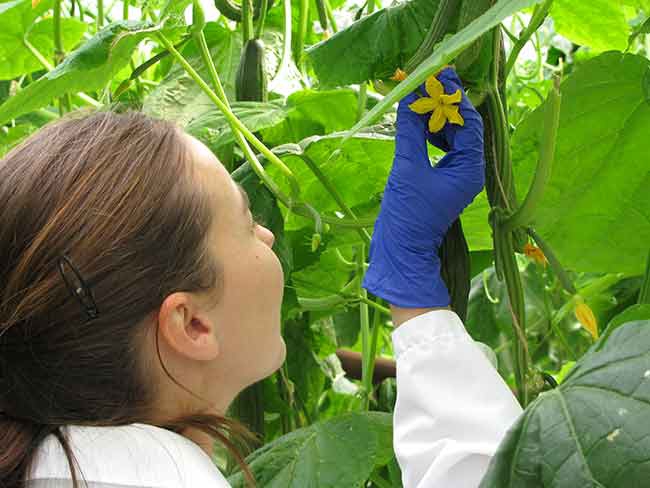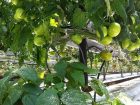
Features
Biocontrols
Inputs
Pest Defence: Scouting to Save Money
Time spent scouting increases when there is higher pest pressure and when plants are tall and dense, because scouting takes longer on carts than it does on foot.
July 11, 2016 By Dr. Ishtiaq Rao
 Crop Defenders crop advisor Nicole Stewart scouting for thrips on a greenhouse cucumber flower.
Crop Defenders crop advisor Nicole Stewart scouting for thrips on a greenhouse cucumber flower. August 2016 – Crop Defenders Ltd. considers pest management as having three major foundations: (1) good cleanout, (2) proficient scouting, and (3) timely/proactive treatment with biological control agents (biologicals).
Why your greenhouse needs scouting. Scouting is done to gain insight into the pests, diseases and beneficial insect activities in crops. Proper scouting provides early detection of pest problems that saves money and hassle; tracks long-term and short-term trends in population levels of the pest or biologicals; enables the grower to identify the optimal time and method for treatment; and measures the effectiveness of a management action (biological control, or chemical insecticide treatment).
Materials for getting started. To start scouting, collect the following scouting supplies:
- A hand lens (ideally 10-40X) or an optivisor.
- Disposable gloves to touch diseased or infested plants.
- Glass vials or plastic baggies for collecting unknown insects for identification.
- Clean, white lab coat. Scouts should never wear bright colours, especially yellow or blue. Bright colours attract insects, and scouts will carry pests from hot spots to other areas of the facility while inspecting the crop.
- Sticky cards.
- Coloured survey flags/flagging tape. At Crop Defenders, we colour code our flagging tape (pink is spider mite, orange is a spider mite hot spot, blue for aphids, green for whitefly and yellow for miscellaneous diseases and other pests).
- Hand counter.
- A small brush.
- Potato disks (for fungus gnat monitoring).
- Clipboard, paper, pencil, permanent marker.
Record your discoveries. Keeping records is essential in order to monitor pests and beneficial insects over time. The type of information you will want to keep record of includes completed scouting forms, greenhouse maps, information on biological control use or pesticide applications, fertilizer rates, pesticide label fact sheets, virus testing results, and anything else you believe could inform pest control decisions.
Pick a day and time at which scouting should be done, and do it the same time every week. When setting the schedule, don’t scout on the same days that pesticides are applied. Check with the grower about re-entry intervals. When selecting a time, high noon is recommended, because the lighting is good and the pests will be most active.
Take your time. Spend at least 45 minutes per acre. Time spent scouting increases when there is higher pest pressure and when plants are tall and dense, because scouting takes longer on carts than it does on foot.
Determine an action threshold for each pest. An action threshold is the population level for a pest at which control is needed to avoid economic loss or aesthetic damage to a crop. Setting ideal action thresholds may come with practice.
Tolerance for infestations depends on numerous factors such as type of pest, crop, stage of crop development, type of damage and time until sale. Thresholds vary from grower to grower.
Formulate a method for scouting; will you count actual numbers of pests on each plant, use presence versus absence, or per cent infestation?
Create a data recording form. This will help keep observations consistent from scout to scout.
Establish a route.
Map out your greenhouse. Maps need to be permanently numbered or labelled by area. These maps should have spaces for information (e.g. date, crop specifics, scale of size, comments about the findings, and actions taken), and include information on walkway placement or irrigation/heat zones.Your route between rows should be random, to ensure a good sample of the area.
Inspect 10-20 locations per unit. Visit high-risk hot spot areas regularly. This includes the areas with previous pest history, areas of high heat, near entrances, around circulating fans and along the perimeter of the greenhouse.
Monitor using traps. This includes sticky cards, indicator plants, potato disks, and others. The sticky trap in each section must be mounted four to eight inches above the plant canopy, accessible for detection and counting and not easily disturbed by workers. It should be fixed with the flat side against the flow of air to capture more pests.
Indicator plants, such as bush beans for monitoring thrips and spider mites in tomato greenhouses, provide an early indication of pest invasion. In our experience, bush beans in tomato greenhouses are more attractive for thrips than even blue sticky cards.
If your indicator plants are highly infested, you should remove them from the growing area and replace them. Don’t spray your indicator plants, because they will no longer attract pests.
A quarter-inch slice of raw potato on the medium is a good method for trapping pest larvae of fungus gnats for easier detection and counting.
Scouting: the art of observation. While scouting, observe the entire plant. Randomly inspect plants along established routes for insects, natural enemies, diseases or physical abnormalities.
Every 10 steps, switch from checking new growth to middle canopy and to lower canopy.
Check leaves for discoloration; yellow specks could indicate early spider mite infestation and white flecks (honeydew) could indicate an aphid infestation.
Take flower samples and cut them open to check for adult thrips.
Use laminated sheets of white paper under leaves and gently tap plants to dislodge insects after inspecting the undersides of foliage.
If you’re using biological control, also keep count of the beneficial insects, their percentage of kill (ask your biocontrol provider to train scouts to recognize signs of parasitism), and the effectiveness of control that the biological insects are providing.
A good scout can recognize different instars of pests and beneficials, and this information can greatly inform population trends and help in making management decisions.
Check sticky cards to monitor increases and decreases in populations of pests. Mark results on the scouting form. Evaluate the data and determine if management action is required.
Dr. Ishtiaq Rao is the business manager with Crop Defenders Ltd., www.cropdefenders.com.
Print this page


